Alabama is home to around 449 species of birds. Among these species are hawks that live across the whole state during the breeding and non-breeding seasons. Hawks are incredible birds of prey that live in virtually every single habitat on earth. They hunt in rainforests, prairies, marshes, meadows, deserts, farms, and forests.
In this article, we will look at seven types of hawks in Alabama. In the state’s extensive woodlands, birders can find red-tailed hawks, Cooper’s hawks, red-shouldered hawks, and broad-winged hawks; specialists in this habitat.
1. Sharp-shinned Hawk
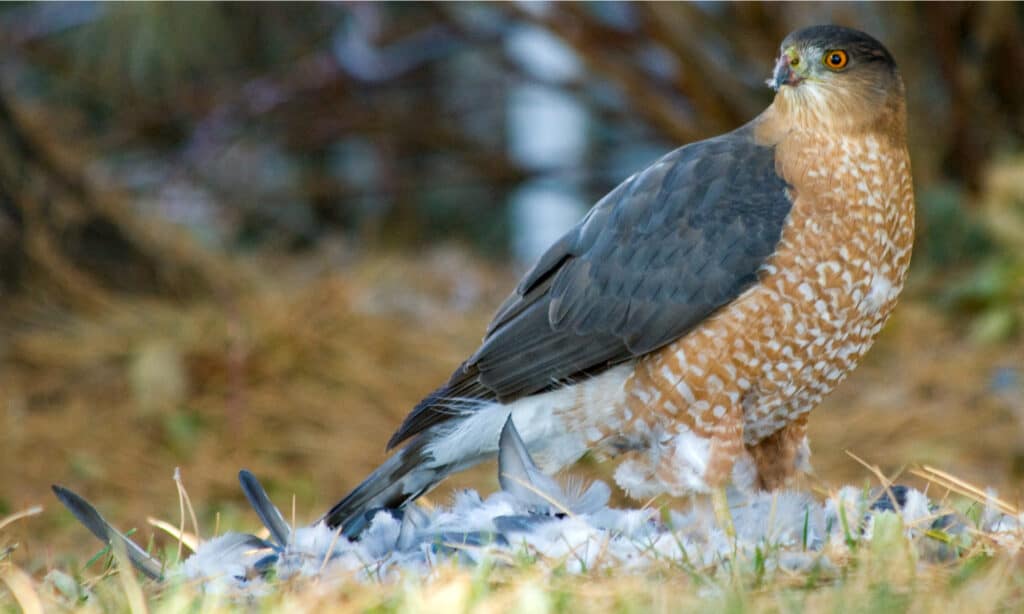
Sharp-shinned hawks have short, rounded wings with square-tipped tails.
©Wyatt W/Shutterstock.com
| Sharp-shinned Hawk | |
|---|---|
| Scientific name | Accipiter striatus |
| Weight | 2.9-7.7 oz (82-219 g) |
| Height | 9.1-15 in (23-37 cm) |
| Wingspan | 17-27 in (42-68 cm) |
Sharp-shinned hawks are the smallest of the accipiters in North America. They have short, rounded wings with square-tipped tails. Females are larger than males. Adults are grayish on top with a rufous barring on their underparts. The immature hawks are brown above with dark streaks on their underparts. They are not so common in Alabama. You can only see the non-breeding populations within the state during winter.
Sharp-shinned hawks are named after their featherless, sharply-keeled lower legs. They nest in groves of coniferous trees in mixed woods. Their nest is a platform of twigs lined with bark chips and any kind of greenery. Females lay between 4-5 bluish-white eggs that are blotched with brown. The incubation period takes around 30-35 days. Incubation is mainly done by the females, while the males are responsible for bringing food.
Sharp-shinned hawks hunt by stealth. They are primarily on their wings when searching for prey. Sometimes they hide in foliage or on a perch and wait for prey to approach. They feed on small birds, rodents, snakes, large insects, frogs, lizards, and many other small mammals.
2. Rough-Legged Hawk
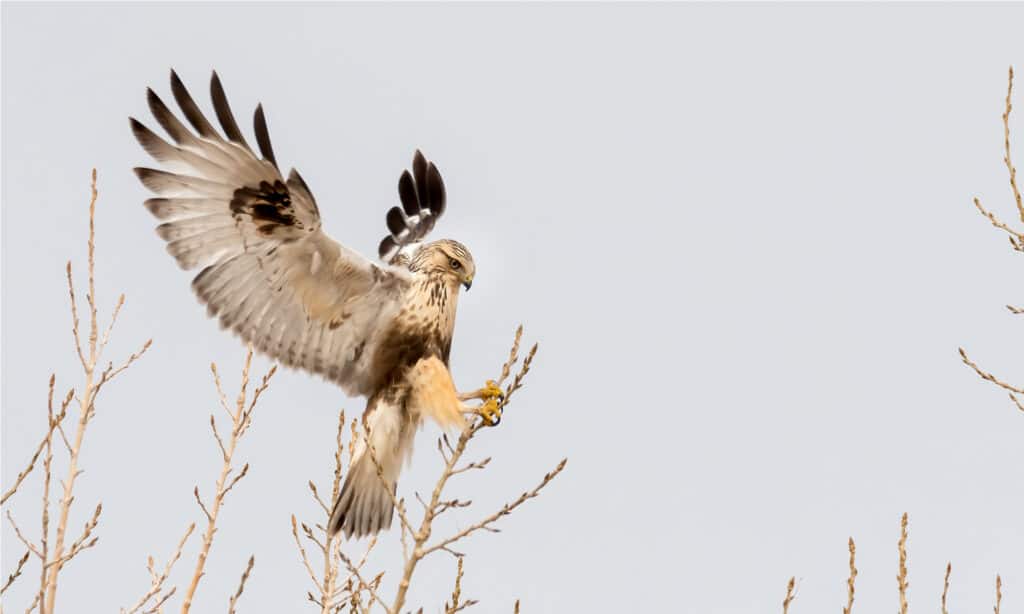
Rough-legged hawks are a type of soaring Buteo hawk often spotted in Alabama during winter.
©Eivor Kuchta/Shutterstock.com
| Rough-Legged Hawk | |
|---|---|
| Scientific name | Buteo lagopus |
| Weight | 1.32-3.66 lbs (599-1660 g) |
| Height | 18-24 in (46-60 cm) |
| Wingspan | 52-54 in (132-138 cm) |
Rough-legged hawks are a type of soaring Buteo hawk often spotted in Alabama during winter. In the winter, they spend most of their time in open fields and prairies, but in the summer and spring, they nest on tundra escarpments. These hawks are named after their feathered legs. Their color varies from dark melanistic to light, with dark bands across their chests.
Rough-legged hawks build their nests on the tops of trees and cliff ledges. Some may breed along the northern edge of the coniferous forest zone. Their nest is a bulky structure of debris, bones, and sticks lined with twigs and grasses. Females lay between 3 and 5 pale bluish-white eggs spotted with violet or brown. Females carry out incubation, though males may sit on the eggs briefly.
Rough-legged hawks hunt by hovering over agricultural fields and grasslands in search of prey. They may also hunt by watching from a raised perch. These hawks feed primarily on small rodents like voles and lemmings.
3. Red-tailed Hawk
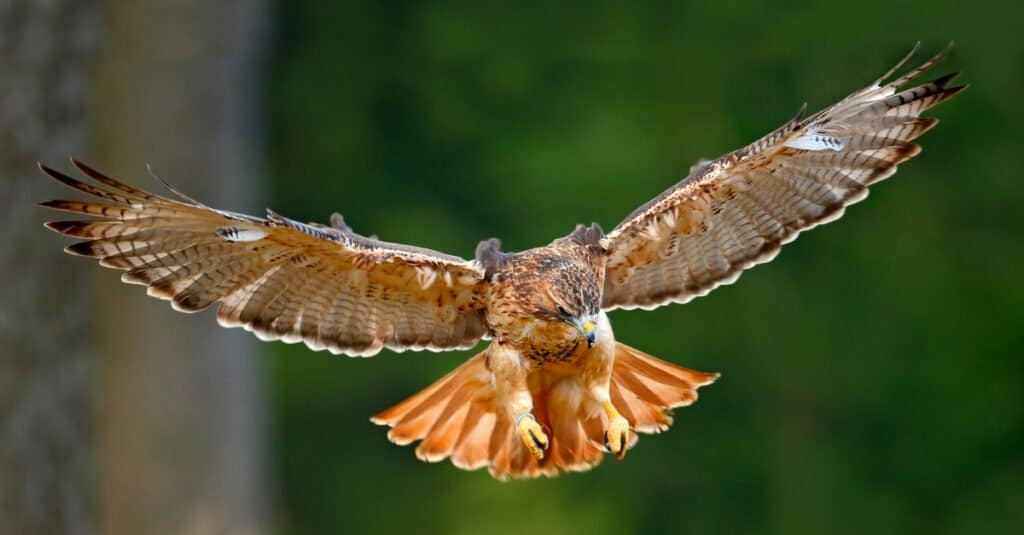
Red-tailed hawks have broad, rounded wings with short, broad tails.
©Ondrej Prosicky/Shutterstock.com
| Red-tailed Hawk | |
|---|---|
| Scientific name | Buteo jamaicensis |
| Weight | 1.5-3.5 lbs (680-1586 g) |
| Height | 18-26 in (45-65 cm) |
| Wingspan | 43-56 in (110-141 cm) |
Red-tailed hawks are also buteos like red-shouldered hawks. They are the second-largest hawks in America and are often spotted in Alabama. They are deep brown above with brightly pale streaked undersides. They have broad, rounded wings with short, broad tails. You might confuse large red-tailed hawks with eagles when you see them from a distance. These hawks are named after their cinnamon-red tails.
Red-tailed hawks are often sighted along the roadsides, in mountains, prairie groves, and the woodlands. They are found in any kind of ecosystem that provides an open ground for high perches and hunting. So, you’re most likely to run into them while on a road trip.
Their nest sites are also variable. They may build their nests among the arms of giant cacti, on artificial structures, cliff ledges, or on top of tall trees. Nests are built by both sexes using bulky sticks lined with finer materials. Females lay between 2-3 whitish eggs that are spotted with brown. The incubation period lasts for about 28-35 days.
4. Broad-winged Hawk
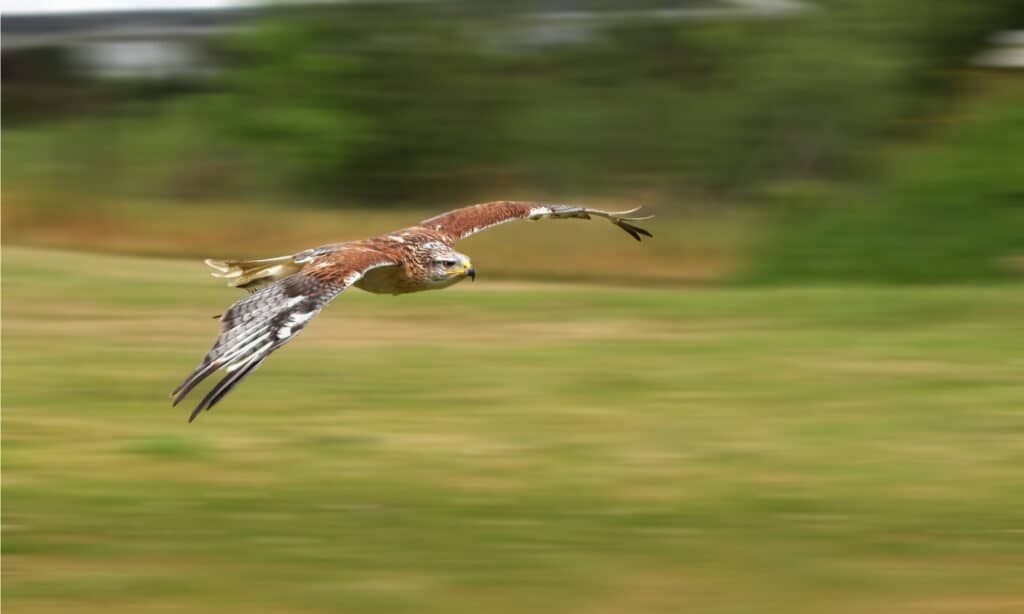
Broad-winged hawks breed in deciduous trees or mixed coniferous-deciduous forests.
©pr2is/Shutterstock.com
| Broad-winged Hawk | |
|---|---|
| Scientific name | Buteo platypterus |
| Weight | 9.3-19.8 oz (264-561 g) |
| Height | 13.4-17.3 in (34-44 cm) |
| Wingspan | 31.9-39.4 in (81-100 cm) |
Broad-winged hawks are the smallest Buteos common in Alabama woodlands in summer. They spend most of their time around the edges of a forest. They have distinct chunky bodies, broad wings, large reddish-brown heads, and black-and-white banded tails. Their undersides are pale and bordered in dark brown. Get a chance to see these hawks by visiting Alabama in the fall when they are migrating to Central America.
Broad-winged hawks breed in deciduous trees or mixed coniferous-deciduous forests, usually near clearings, edges, or water. Both sexes build a nest consisting of bulky sticks lined with softer materials. Females lay between 2-3 whitish eggs with brown spots. The incubation period takes about 28-31 days, and it’s done by females. Males are in charge of providing food for the females during incubation.
Broad-winged hawks hunt from small raised perches underneath the forest canopy. They swoop down to capture the prey upon spotting it. They sometimes hunt by flying through the woods. They feed primarily on voles, mice, squirrels, large insects, young turtles, and small birds, among other mammals.
5. Northern Harrier

Northern harriers’ diet consists of rats, voles, small birds, toads, frogs, snakes, and large insects.
©Harry Collins Photography/Shutterstock.com
| Northern Harrier | |
|---|---|
| Scientific name | Circus hudsonius |
| Weight | 11-27 oz (300-750 g) |
| Height | 21-25 in (53-64 cm) |
| Wingspan | 41-46 in (103-117 cm) |
Northern harriers are very distinctive hawks that are found in Alabama, especially during the winter. They are medium-sized raptors with long wings and long tails. Males are gray on top and whitish underneath, with black-banded tails. Females and the young ones are brown above, with black-banded tails as well.
These hawks hunt by flying low over fields or in dense cover in an attempt to drive out prey. They eat their meals on the ground and perch on low trees and utility posts. Their diet consists of rats, voles, small birds, toads, frogs, snakes, and large insects. They feed on carrion during the winter.
Northern harriers inhabit the prairies, fields, and marshes. They build their nests on the ground in marshes or dense fields. Females build the nest while males supply the materials. Females lay between 4-6 pale bluish-white eggs that hatch in roughly 30-32 days.
6. Cooper’s Hawk

Cooper’s hawks feed on small birds, chipmunks, ground squirrels, mice, bats, tree squirrels, and large insects.
©Richard G Smith/Shutterstock.com
| Cooper’s Hawk | |
|---|---|
| Scientific name | Accipiter cooperii |
| Weight | 7.8-14.5 oz (220-410 g) |
| Height | 14-20 in (35-50 cm) |
| Wingspan | 24-39 in (62-99 cm) |
Cooper’s hawks are medium-sized accipiter hawks that are found in Alabama year-round. They are blue-gray above with a red-orange breast, making it hard to differentiate between them and the sharp-shinned hawks.
These hawks are sighted primarily on open woodlands and river groves but nest in deciduous or coniferous forests with openings or edges. Females lay 3-5 pale-bluish eggs that hatch in about 34-36 days.
Cooper’s hawks feed on small birds, chipmunks, ground squirrels, mice, bats, tree squirrels, and large insects. They wait and listen for prey from a raised perch. You may also spot them in backyards trying to catch songbirds, jays, and robins.
7. Red-shouldered Hawk
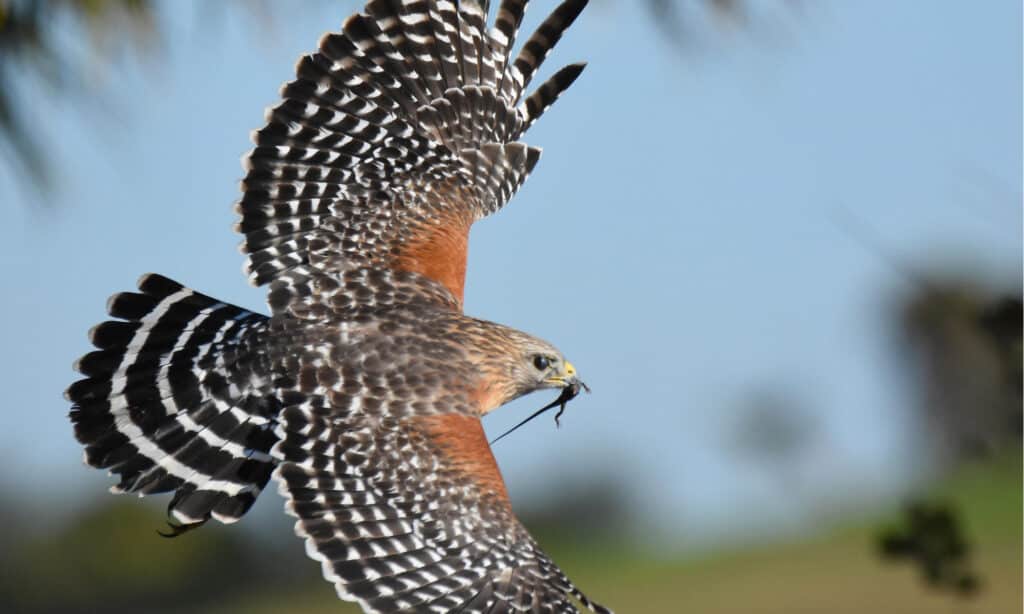
Red-shouldered hawks build their nests in deciduous or mixed forests near rivers or wetlands.
©MTKhaled mahmud/Shutterstock.com
| Red-shouldered Hawk | |
|---|---|
| Scientific name | Buteo lineatus |
| Weight | 1-1.7 lbs (486-774 g) |
| Height | 15-24 in (38-61 cm) |
| Wingspan | 35-50 in (90-127 cm) |
Also known as the hawks of woodlands, red-shouldered hawks can be spotted in Alabama. However, their population is currently facing a significant decline globally. They have a warm reddish barring on the breast that differentiates them from other species of hawks.
Red-shouldered hawks build their nests in deciduous or mixed forests near rivers or wetlands. Both sexes construct a nest that can be utilized for multiple seasons. Females lay three to four pale bluish-white eggs.
Their diet consists of small birds, voles, chipmunks, frogs, toads, snakes, mice, and insects. They prefer to take these creatures by surprise, so they hunt by watching for them from a perch.
The photo featured at the top of this post is © pr2is/Shutterstock.com
Thank you for reading! Have some feedback for us? Contact the AZ Animals editorial team.







